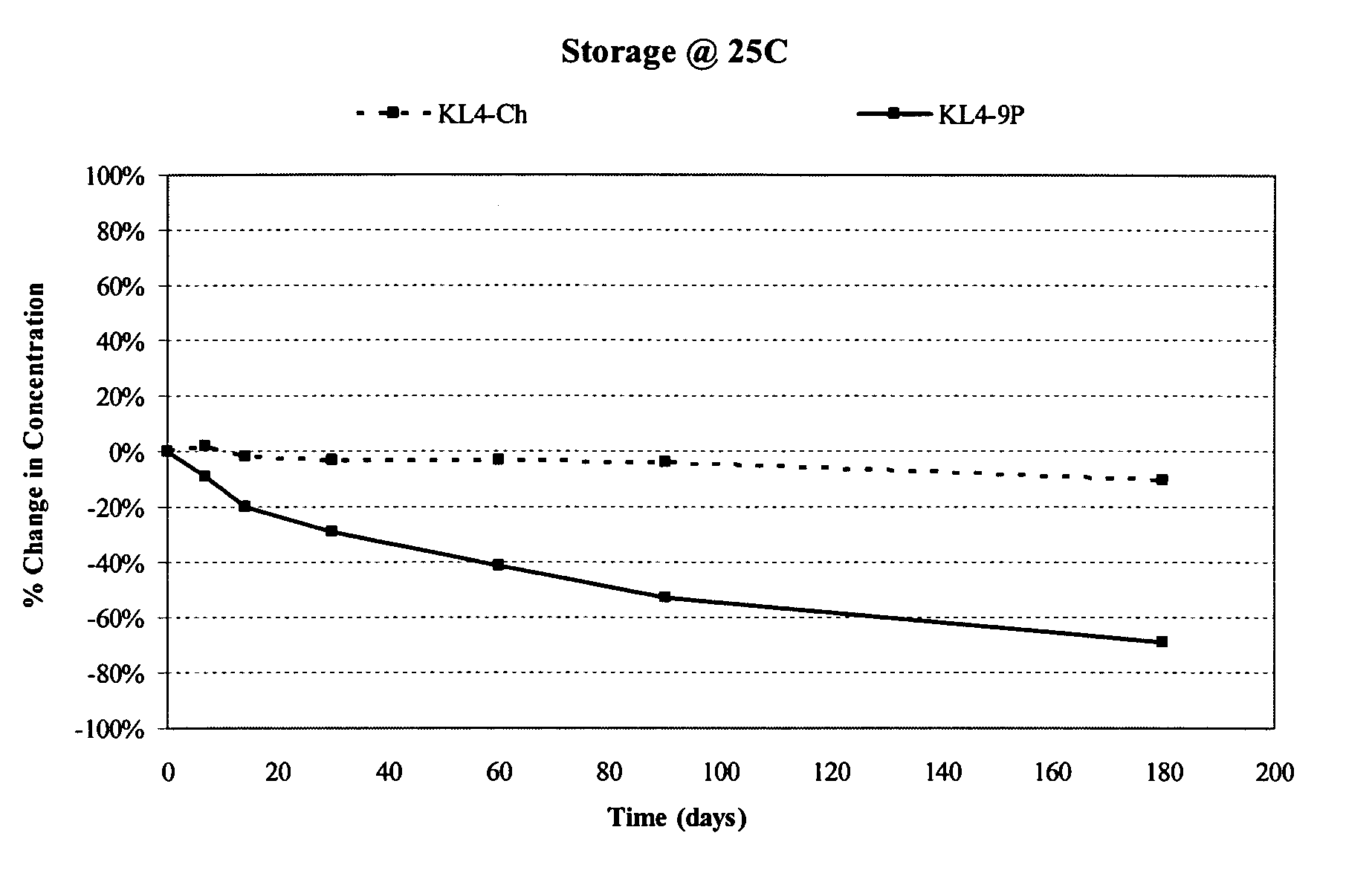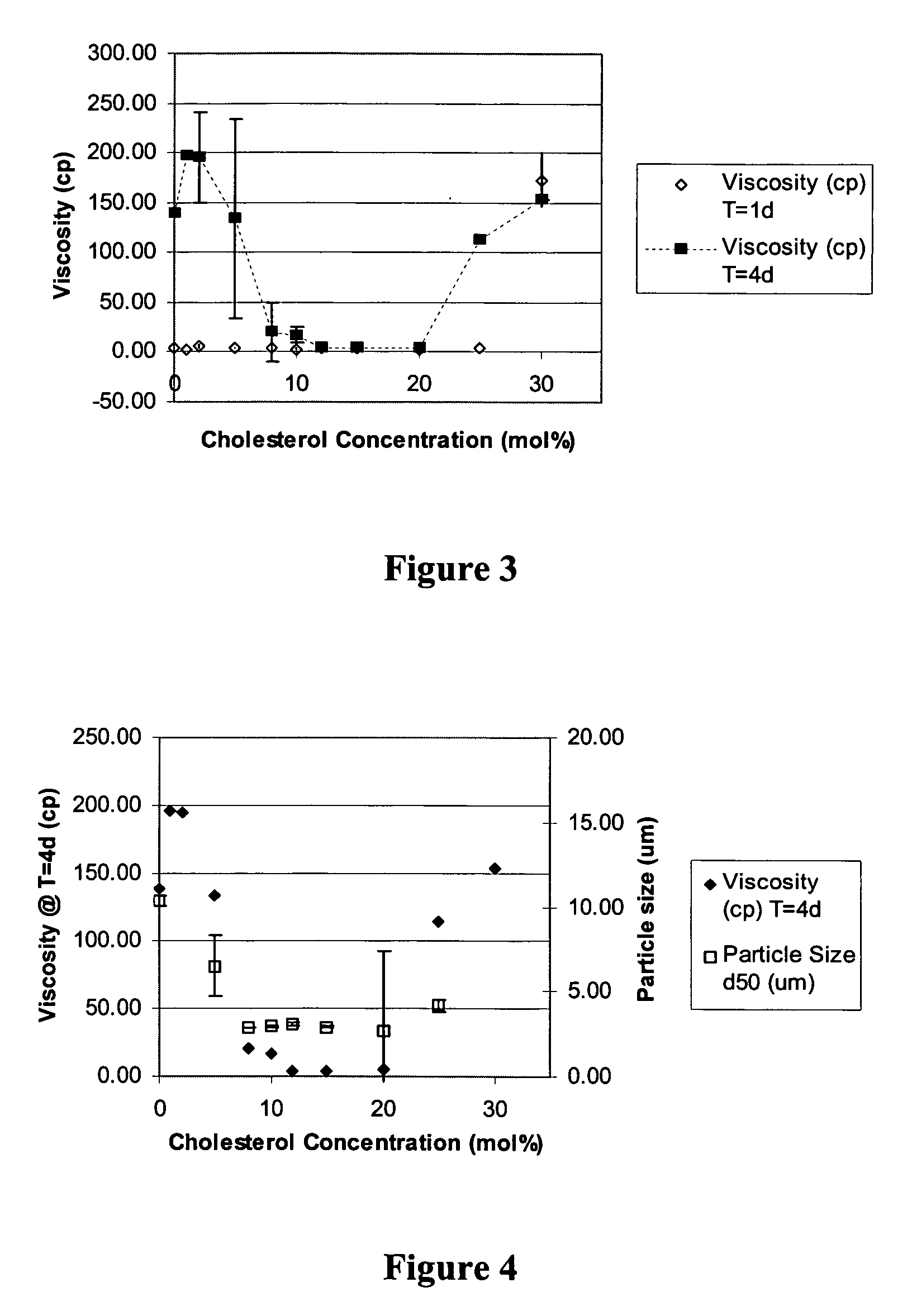Pulmonary surfactant formulations
- Summary
- Abstract
- Description
- Claims
- Application Information
AI Technical Summary
Benefits of technology
Problems solved by technology
Method used
Image
Examples
example 1
Development of Novel Lung Surfactant Formulation Containing DPPG and Cholesterol
[0257] Formulation of Lung Surfactant: Lab-scale formulations were prepared at 60 mg / ml (TPL) with the cholesterol content variations described below (Table 3). Each formulation was prepared in n=1-5 (see lot numbers and names in Table 3) and individually characterized. The appropriate amounts (Table 3) of DPPC, POPG / DPPG, PA / cholesterol and KL4 by weight were sequentially added to a round bottom flask containing appropriate volumes of ethanol, which was heated to 45-50° C. Each of the components was added with 1-2 minutes application of bath sonication. Finally, after each of components was added, the flask was bath sonicated for 5 more minutes. The flask was attached to a rotary evaporator and the ethanol was evaporated at 55° C. The speed of the rotary evaporator was ˜50 rpm and a vacuum of <10 mbar was applied. When there was about 15 mls of ethanol remaining in the flask, the speed of the rotary e...
example 2
Development of Novel Lung Surfactant Formulation Containing DPPG and Cholesterol-II.
[0272] Formulation of Lung Surfactant. Lab-scale formulations were prepared at 60 mg / ml (TPL) according to DOP-017, with the appropriate changes for cholesterol content variations described below (Table 4). Each formulation was prepared in formulation was prepared in triplicate (see lot numbers and names in Table 4) and individually characterized.
TABLE 4Formulation Lot Numbers, Names, and Cholesterol Target ConcentrationsFormulation LotCholesterolConcentrationNameNumbermol (%)mg / mL 2Ch1A0170-14-2Ch120.32 2Ch2A0170-14-2Ch220.32 2Ch3A0170-14-2Ch320.32 8Ch1A0170-15-8Ch181.26 8Ch2A0170-15-8Ch281.26 8Ch3A0170-15-8Ch381.2610Ch1A0170-14-10Ch1101.5810Ch2A0170-14-10Ch2101.5810Ch3A0170-14-10Ch3101.5812Ch1A0174-7-12Ch1121.8912Ch2A0174-7-12Ch2121.8912Ch3A0174-7-12Ch3121.8915Ch1A0174-7-15Ch1152.3615Ch2A0174-7-15Ch2152.3615Ch3A0174-7-15Ch3152.36
[0273] Analytical assays and procedures that were used to characte...
example 3
In Vivo Activity of a Cholesterol-Containing Composition.
[0283] The change in the volume of the respiratory system is measured by placing an animal, in this case a pre-term rabbit, in a plethysmograph, and measuring the change in volume of gas into and out of the plethysmograph with a flow meter, or pneumotachograph. The stiffness of the respiratory system is calculated by dividing the tidal volume change by the airway pressure change during a mechanical breath. The parameter for this stiffness is the compliance of the respiratory system (Crs).
[0284] In surfactant-deficient fetal-rabbits treated with surfactant, Crs is expected to increase during mechanical ventilation, and reach a plateau in approximately 10-30 minutes. This increase is due to the spreading of the surfactant and the establishment of a surface-active lining of the alveoli. In surfactant-deficient animals, there can be a small increase in the Crs with mechanical ventilation due to the release of minimal stores of ...
PUM
| Property | Measurement | Unit |
|---|---|---|
| Force | aaaaa | aaaaa |
| Diameter | aaaaa | aaaaa |
| Diameter | aaaaa | aaaaa |
Abstract
Description
Claims
Application Information
 Login to View More
Login to View More - R&D
- Intellectual Property
- Life Sciences
- Materials
- Tech Scout
- Unparalleled Data Quality
- Higher Quality Content
- 60% Fewer Hallucinations
Browse by: Latest US Patents, China's latest patents, Technical Efficacy Thesaurus, Application Domain, Technology Topic, Popular Technical Reports.
© 2025 PatSnap. All rights reserved.Legal|Privacy policy|Modern Slavery Act Transparency Statement|Sitemap|About US| Contact US: help@patsnap.com



